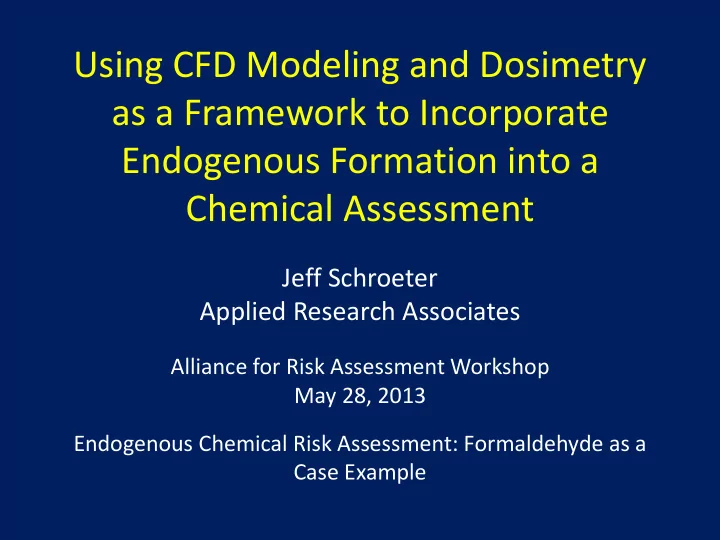

Using CFD Modeling and Dosimetry as a Framework to Incorporate Endogenous Formation into a Chemical Assessment Jeff Schroeter Applied Research Associates Alliance for Risk Assessment Workshop May 28, 2013 Endogenous Chemical Risk Assessment: Formaldehyde as a Case Example
Background • Formaldehyde is an endogenous compound that is present in human blood and tissues • Formaldehyde has been measured in exhaled breath at concentrations of several parts per billion - indicates off-gassing of formaldehyde from respiratory tissues • National Research Council (2009): “The endogenous production of formaldehyde complicates the assessment of the risk associated with formaldehyde inhalation and remains an important uncertainty in assessing the additional dose received by inhalation ”
Purpose Quantify the target tissue dosimetry of inhaled exogenous formaldehyde in the nasal passages in the presence of endogenous formaldehyde • Computational fluid dynamics (CFD) models of the nasal passages of a rat, monkey, and human were used to simulate inhaled formaldehyde in the presence of endogenous formaldehyde in nasal tissues
CFD Modeling of Vapor Uptake • Develop 3D reconstructions of the model surface -- rat, monkey, and human nasal passages • Solve airflow equations in each species • Apply boundary conditions and simulate vapor uptake • Analyze wall mass flux patterns and site-specific flux
Formaldehyde Nasal Dosimetry Modeling From Kimbell et al. (2001)
Strengths • Anatomically accurate reconstructions of the nasal airways were used to simulate the complex airflow patterns and nonlinear formaldehyde uptake • Site-specific flux predictions were obtained for comparisons across species Limitations • Mass transfer rates were calibrated to formaldehyde rat nasal uptake measurements at high exposure concentrations (> 2 ppm) • Endogenous formaldehyde cannot be incorporated into the models using this approach
Interspecies Nasal CFD Models Rat Monkey Human
Updates to Kimbell et al. (2001) Models • Smoother surface contours in the rat and monkey models • New human nasal model based on high-res CT scans • High-density numerical meshes for improved accuracy • Modified boundary condition to include formaldehyde pharmacokinetics and endogenous production
Formaldehyde Mass Transfer
Implement a mass transfer boundary condition based on formaldehyde kinetics: • Physico-chemical properties: diffusivity, partitioning • Clearance properties: parameters from Conolly et al. (2000) • Endogenous production: rate constant in each species calibrated to nasal tissue levels The modified nasal CFD models are capable of predicting site- specific formaldehyde absorption or desorption (off-gassing) depending on formaldehyde air and mucosal concentrations
Formaldehyde Dosimetry Simulations • Steady-state inspiratory airflow was simulated in each model at flow rates equal to twice estimated minute volume for resting breathing • Formaldehyde uptake was simulated using the mass transfer approach based on formaldehyde kinetics (including endogenous production) • Endogenous formaldehyde production rates were calibrated to yield nasal mucosal concentrations of 0.4 µmol/g • Formaldehyde uptake simulations were conducted at exposure concentrations from 0.001 – 10 ppm
Formaldehyde Nasal Uptake Exposure Nasal Uptake (%) Concentration (ppm) Monkey Human Rat 86.5 85.3 1.0 99.4 86.5 84.7 0.1 98.6 84.1 77.1 0.01 91.3 n/a 1 42.8 0.001 17.5
Formaldehyde Exposure Levels Air concentration (ppb) From Salthammer et al. (2010) Sensory irritation
CFD Outputs to BBDR Model • Rat, monkey: Average flux values were computed in regions where DPX and cell proliferation were measured - exposure concentrations: 0.7, 2, 6, 10, 15 ppm • Human: A flux binning procedure was applied to partition the human nasal surface into regions of similar flux - exposure concentrations: 0.001 – 1 ppm
Conclusions • Nasal uptake of inhaled formaldehyde is high (> 85%) at exposure concentrations > 500 ppb • The presence of endogenous formaldehyde did not affect formaldehyde absorption at exposure concentrations > 500 ppb • Reduced nasal tissue dose was predicted at exposure concentrations < 500 ppb due to the presence of endogenous formaldehyde • Sharply reduced tissue dose was predicted at exposure concentrations < 10 ppb • Net desorption of formaldehyde was predicted in humans at exposure concentrations ≤ 1 ppb
Acknowledgments Harvey Clewell Jerry Campbell Mel Andersen Rory Conolly Julie Kimbell Robinan Gentry Funding This study was funded by the Research Foundation for Health and Environmental Effects
Recommend
More recommend